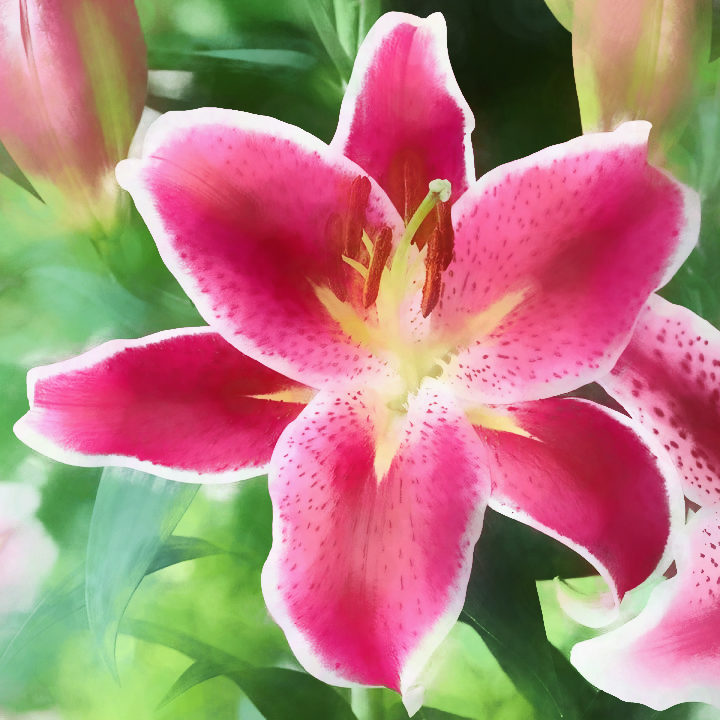
Lilium sp.
(Plantae, Tracheophytes, Angiosperms, Monocots, Liliales, Liliaceae, Lilioideae, Lilieae, Lilium sp.).
Members of the genus Lilium. are considered “true lilies”. Other flowering plants with “lily” in their name but not from the genus Lilium are not true lilies (daylilies, peace lilies, canna lilies, water lilies, toad lilies, and calla lilies). Butterflies are attracted to lilies, but these flowers are toxic for cats and dogs. Natural pests include the lily beetle and deer. Asiatic species have some amazing and very interesting colors plus distinctive markings like spots. The Oriental species are known for their strong fragrance. Longiflorum lilies are popular during Easter.
Habitat/Growing Information.
Lilies have large flowers and grow from bulbs. The flower has 6 trumpet-shaped tepals–3 on the bottom and 3 on top (top flowers rotated so that all 6 flowers are visible. These lovely flowers range in colors from orange, red, pink, white, and yellow. Lilies do well in both full and part sun in hardiness zones 4-8.
They prefer well-drained loamy soil (1 inch of rain per week). Lilies grow from 2-4 feet–one flower per one shoot per one bulb. Lilies can also grow in containers, but it is important that the soil be well-drained and that the plant gets enough sunlight. It is probably better to plant them outdoors eventually. Since the flowers are big and top-heavy, be sure to plant the bulb 7-10 inches deep into the soil.
Parts utilized.
Depending on the species of Lilium, different parts are used for different medicinal/therapeutic purposes. The flowers, leaves, stem, and root may be harvested.
Properties.
Lilium candidum aka. Madonna lily has historically been harvested for its beautiful flower and also for the medicinal properties of its bulb/root: treatment for burns; ulcers; inflammations; wounds (especially with pus); analgesic properties; (Özen, Temeltaş, & Aksoy, 2012; Patocka, Navratilova, & Yokozawa, 2019). Patocka et al. (2019) studied the ethanol extract of the flower and bulb finding flavonoids quercetin, isorhamnetin, and kaempferol.
Other studies identified various species of Lilium to have (but not limited to): carotenoids, saponins, sterol alkaloids, pyrrole alkaloids (lilalin, jatrophan), steroids (beta-sitosterol), acylglycerols, phenylpropanoids, and tannins (Wang et al., 2019). Lilium sp. have been used for anti-tumor, hypoglycemia, antibacterial, anti-inflammatory, hypolipidemia, attenuating blood sugar, antioxidants, anti-depression, and anti-fatigue (Wang et al., 2019).
References
- https://www.thespruce.com/lily-types-to-grow-in-garden-1315809
- https://www.gardendesign.com/flowers/lilies.html
- https://garden.org/plants/group/lilies/
- http://mediplantepirus.med.uoi.gr/pharmacology_en/plant_details.php?id=388
- Özen, F. A. Z. I. L., Temeltaş, H. A. C. I., & Aksoy, Ö. Z. L. E. M. (2012). The anatomy and morphology of the medicinal plant, Lilium candidum L.(Liliaceae), distributed in Marmara region of Turkey. Pak. J. Bot, 44(4), 1185-1192.
- Patocka, J., Navratilova, Z., & Yokozawa, T. (2019). Bioactivity of Lilium candidum L-A Mini Review. Biomedical Journal of Scientific & Technical Research, 18(5), 13859-13862.
- Wang, P., Li, J., Attia, F. A. K., Kang, W., Wei, J., Liu, Z., & Li, C. (2019). A critical review on chemical constituents and pharmacological effects of Lilium. Food Science and Human Wellness, 8(4), 330-336.
- https://en.wikipedia.org/wiki/Lilium
- https://www.almanac.com/plant/lilies
